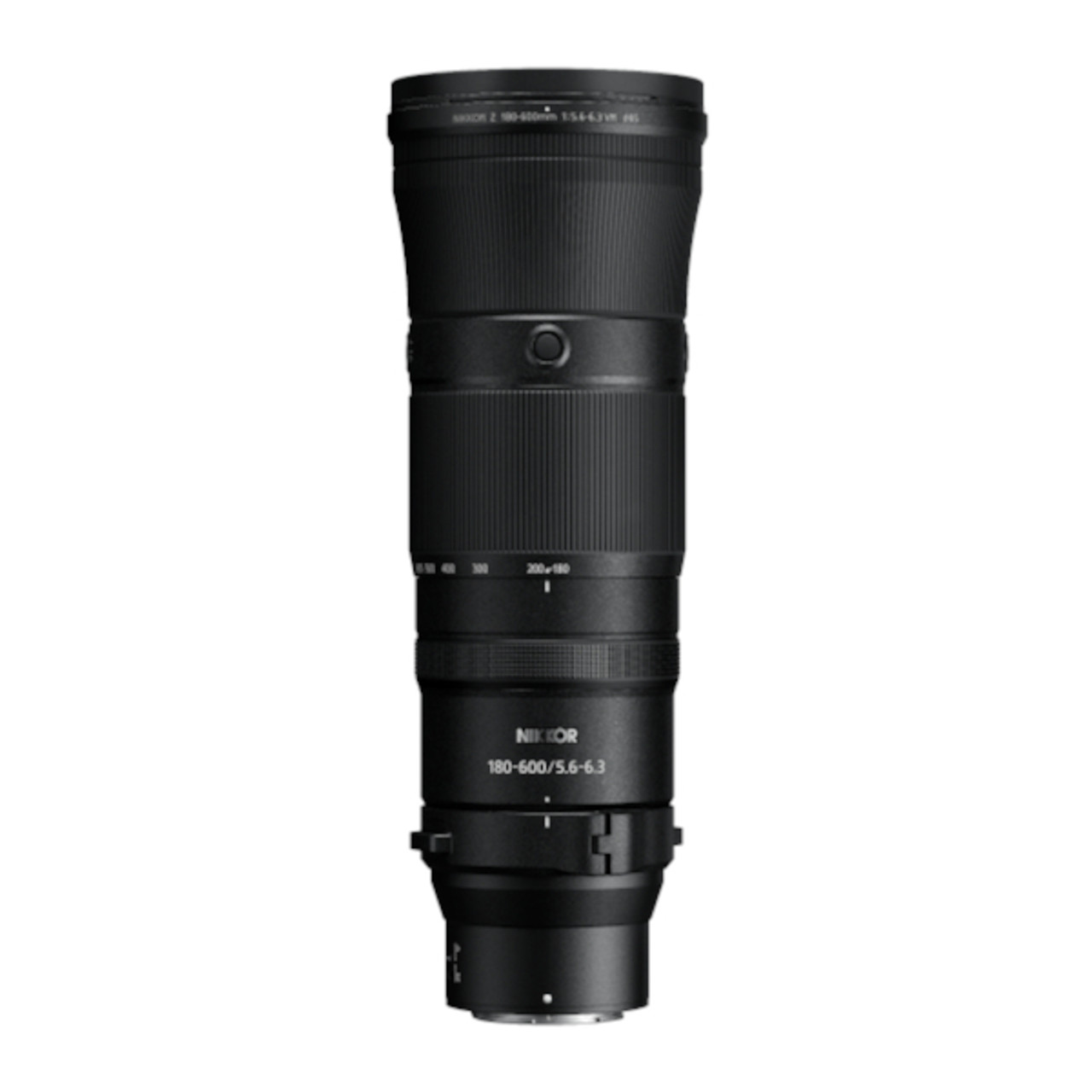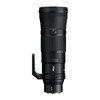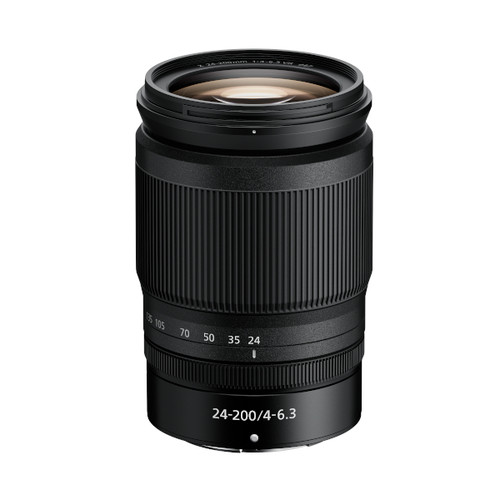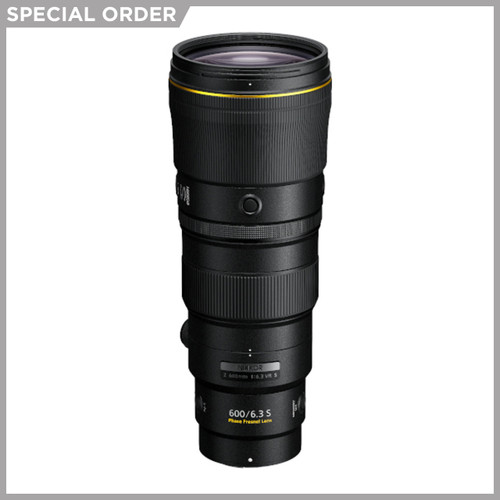Product Description
Go the distance.
So much reach. So much versatility.
Capture thrilling photos and videos of wildlife, sports, aircraft and more with Nikon’s farthest reaching zoom lens for Z series mirrorless cameras. Comfortable and balanced for quick handheld shooting. Durable and weather sealed for rough conditions. Sharp and clear across the entire 180-600mm zoom range, and compatible with teleconverters for up to 2x more reach.
- 180-600mm
- Super-Telephoto Zoom
- Internal Zoom
- Lens Length Never Changes
- VR
- Image Stabilization
- (5.5 stops)
- 1995 g
- Comfortable Weight
- Z Mount
- Full Frame/FX-format
Expand your capabilities.
The NIKKOR Z 180-600mm f/5.6-6.3 VR takes you far beyond the reach of standard and telephoto zoom lenses, making the most distant shots suddenly possible.
Powerful 180mm-600mm range.
At its widest setting, the NIKKOR Z 180-600mm f/5.6-6.3 VR is great for locating your subject. With a mere quarter turn of the zoom ring, you can reach all the way to 600mm for tight framing with beautiful background compression.
Comfortable handheld shooting.
The NIKKOR Z 180-600mm f/5.6-6.3 VR is among the lightest super-telephoto zoom lenses in its class*, and since it doesn’t expand/retract, it handles the same at every zoom position.
*According to Nikon research of comparable full-frame mirrorless lenses as of June, 2023.
Short-throw internal zoom.
An all-internal design eliminates extending/retracting, improving handling, with only a 70° turn needed to go from 180mm to 600mm. The design also prevents dust or moisture from entering those moving parts.
Versatile close focusing.
With a minimum focus distance of just 4.27 ft at the 180mm zoom position and a large 0.25x reproduction ratio, you can turn an unexpected close encounter into a once-in-a-lifetime photo or video.
Up to 5.5 stops of VR.
Built-in optical Vibration Reduction (VR) provides a stabilization effect equivalent to a shutter speed of 5.5 stops* faster, reducing camera blur when panning to track fast-moving subjects.
*Based on CIPA Standard; in [Normal] mode at the telephoto end when attached to a full-frame/FX-format camera.
Sharp in low light.
Built-in optical VR image stabilization also allows you to shoot at slower shutter speeds to gather more light at dusk, dawn or in a dense forest.
Quiet, accurate autofocus.
Reliably track your subjects without mechanical lens noise, crucial for skittish wildlife and video recording.
Pairs great with Z teleconverters.
Increase your reach by 2x (up to 1200mm) or 1.4x (up to 840mm) with Nikon’s Z series teleconverters
(sold separately).
Picks up where the 70-180mm leaves off.
Use both lenses together to cover the entire focal length range from 70-600mm with consistent performance and operation.
Effortless operation.
- Weather sealing.
- Moving parts are sealed against dust and moisture. (Complete dust- and drip-resistance is not guaranteed in all situations.)
- High-speed zoom ring.
- Go from 180mm to 600mm in just 70° of rotation.
- Customizable control ring.
- Smooth, precise and clickless. Manually adjust focus, aperture, ISO or exposure compensation.
- Strap eyelet.
- For carrying the lens on a camera body or on its own—with the optional LN-4 Lens Strap.
- Customizable buttons.
- Subject tracking, AF Lock, image playback and more can be mapped to two conveniently placed L-Fn buttons.
- Quick-release tripod foot.
- Easy on, easy off. Can be rotated for vertical shooting.
Technology
IF Lens
A NIKKOR lens in which only the internal lens group shifts during focusing. Thus, IF NIKKORS do not change in size during AF operation, allowing for compact, lightweight lenses capable of closer focusing distances. These lenses will be designated with the abbreviation IF on the lens barrel.
Stepping Motor
NIKKOR Z lenses use a stepping motor for fast, accurate, smooth, quiet autofocus with reduced wobbling. This quiet drive system makes the lenses ideal for use when shooting video.
ED (Extra-Low Dispersion) Glass
An optical glass developed by Nikon that is used with normal optical glass in telephoto lenses to obtain optimum correction of chromatic aberrations.
Vibration Reduction
A Nikon in-lens technology that improves image stability by automatically compensating for camera shake. Lenses that offer VR will feature the abbreviation VR on the lens barrel.
Fluorine Coat
Photographers need gear that can withstand the elements. Nikon’s fluorine coat effectively repels dust, water droplets, grease or dirt, ensuring easy removal even when they adhere to the lens surface. Nikon’s fluorine coat endures a high frequency of lens surface wiping and its anti-reflective effect also contributes to the capture of clear images.
Aspherical Lens
A lens with a curved, non-spherical surface. Used to reduce aberrations and enable a more compact lens size. Aspherical lenses minimize coma and other types of lens aberrations, even when used at the widest aperture. They are particularly useful in correcting distortion in wide-angle lenses and help contribute to a lighter, more compact design by reducing the number of standard (spherical) elements necessary. Aspherical lens elements correct these distortions by continuously changing the refractive index from the centre of the lens.
A/M
A/M stands for Auto-Priority Manual Mode. This mode also enables an easy transition from autofocus to manual during AF operation. However, mode switch sensitivity has been altered to reduce the possibility of sudden unintentional switching to manual focus while shooting.
Electromagnetic Diaphragm Mechanism
An electromagnetic diaphragm mechanism in the lens barrel provides highly accurate electronic diaphragm or aperture blade control when using auto exposure during continuous shooting.
20230621JH
















